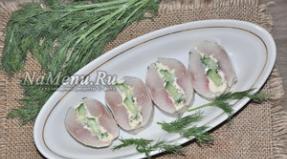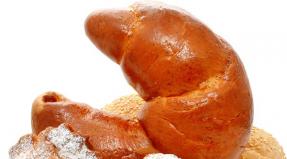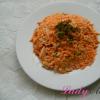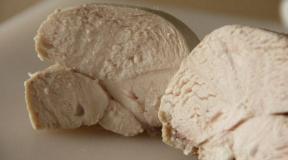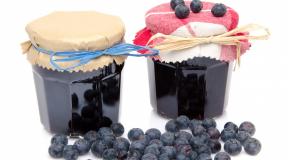Brazil nut - description. Useful properties of Brazil nuts and a number of contraindications
Hello, my dear friends, readers and guests!
Not so long ago, Brazilian ones appeared in our stores. Maybe they appeared a long time ago, but I paid attention to them quite recently, so I decided to get acquainted with their composition and useful properties in more detail.
It turns out that the Brazil nut is just a super healthy product!!! Let's look at the benefits of brazil nuts and how to eat them properly.
Brazil nuts are an extraordinarily powerful and richest known natural source of Selenium (Se) - one of the most essential micronutrients in order to prevent free radical oxidative damage to cells, which causes all the aging processes in our body.
USEFUL PROPERTIES OF THE BRAZIL NUT?;

- Without selenium, there is no synthesis of the necessary enzyme that prevents cell oxidation - glutathione peroxidase.
- Glutathione peroxidase is a critical cellular detoxifier. It converts toxins into harmless by-products, and it also protects our bodies from many environmental and nutritional hazards.
- Increasing the production of glutathione peroxidase helps prevent the development of cancer cells and reduces the risk of cancer.
- Deficiency leads to skin conditions such as acne and psoriasis, and contributes to joint conditions such as rheumatoid arthritis.
- Selenium is also necessary for the proper functioning of the thyroid gland, and insufficient content
- Selenium can be a factor in sudden weight gain or loss.
- Selenium deficiency can lead to muscle weakness and pain in the muscles, discoloration of the skin and hair.
- Brazil nuts are high in zinc, the amino acid arginine and healthy fatty acids, they can increase testosterone levels and endow Brazil nuts with aphrodisiac properties.
- Healing brazil nut oil, getting on the skin, nourishes it, forming a protective layer on the surface of the skin, which prevents aging, as well as excessive evaporation of water.
- In addition, the brazil nut helps to reduce the concentration of bad cholesterol in the body, and at the same time helps to normalize the concentration of sugar.
- Brazil nuts also contain all the essential B vitamins, choline, vitamin E, calcium, magnesium, iron, phosphorus, zinc, manganese and copper.
This amount of selenium contains only one brazil nut. Many health experts believe that this amount of selenium is too low and recommend getting at least 100 micrograms per day. Eat two nuts a day. Isn't it great!?
brazil nut photo

brazil nuts side effects
The National Academy of Sciences has set an upper limit of 400 mcg of selenium per day for adults.
Therefore, you should not consume more than six Brazil nuts a day, as this can cause an overdose of selenium, which manifests itself in the form of nausea and vomiting.
The high fat content of Brazil nuts makes them difficult to store and spoil quickly.
Therefore, when buying, pay attention to the expiration date.
BRAZIL NUT TASTE
The taste of brazil nut kernels, personally, did not remind me of anything similar. The taste is nutty, but not bright and not particularly pronounced, but given all their benefits, this factor can be ignored :)
Calories 656 cal per 100.0 product.
It's very interesting to see how Brazil nuts grow, isn't it impressive?!



What do you know about the exotic Brazil nut?
Is the brazil nut really a chestnut or a seed?
All the truth and myths about the wonderful chestnut from Para, as the real name of the Brazil nut is translated from Portuguese.
The benefits and harms of this nut: What is the benefit? And is it true that Brazil nuts can be harmful? - Find out about everything from the article below!
How does a brazil nut grow?
Few people in Russia know about the Brazil nut, and if they do, then the information is not always complete, I will try to convey everything first-hand, from Brazilian sources. Actually, from those who grow these wonderful chestnuts.

The trees that grow Brazil nuts are quite impressive in size. Approximately 30 to 50 m high, it is like a huge house. The thickness of the trunk is from 1 to 4 m in diameter, so you can’t just hug it! The trees have a spreading large crown. There are no knots and branches along the trunk itself, all the beauty at the top is in the crown.
Chestnuts can live an average of 500 years. But not rare cases when a chestnut (tree) lived 1000 and 1600 years!
The nuts themselves do not grow directly on the tree. Entire "pots" grow on the tree, so to speak, the size of a coconut; inside the pot, nuts ripen, nicknamed in Brazil - chestnuts-from-Para.

Chestnut tree - where do brazil nuts come from

Chestnut Coconut with Nuts - Where do Brazil nuts come from?
In July (winter), the leaves fall off, by spring new leaves appear and flowering occurs. And the tree blooms at once - 1 day! The life of flowers lasts only a day. Then comes the time of fruit ripening. The fruit is a wooden pot with nuts inside. Ripening lasts 12-15 months, in fact almost a year. This is largely due to the very thick shell of the fruit. And finally, in January-February, the fruits fall to the ground.
A fruit with nuts inside can weigh up to 2 kg on average. The shell is similar in composition to wood, has a thickness of 8 to 12 mm. Inside each fruit are from 8 to 24 nuts in the shell. Each nut is about the size of an orange slice.
There is often a small hole in one of the ends of the fruit, through which various insects or animals can try to gnaw the hole and get nuts. Agouti grunt and squirrels often extract shell nuts from fruits, eat some, and bury some in the ground in reserve, but this can be said to be the hidden help of animals for the germination of new chestnut trees. They hatch and then start up new shoots.

Inshell Chestnut Coconut with Brazil Nuts
I must say that these trees do not grow in any tropical forest, but only in forests untouched by man, where they feel at ease. Trees do not grow in marshy places, but only on solid ground. Moreover, they can quite densely populate any territory, or maybe 1 copy per hectare.
To get the nuts, you first need to get these "coconuts", and then cut off the upper part of the "coconut", and get the nuts. Moreover, nuts will not be available even at this stage. Since inside the pot (wooden), the nuts are in a wooden shell, each nut. The shell is in no way inferior to walnut shells in terms of hardness. So it is necessary to cut, saw, break, in general, call it whatever you like - but rid the nut of the shell. And only then can it finally be taken out and eaten.

chestnut in shell

Miku, the smallest Brazilian monkey, takes a Brazil nut from a human hand and cracks open the shell with his sharp teeth.

With special devices, people break the hard shell of chestnuts and extract the nut.
In general, work on opening the "seven locks" for half a day .. like in a fairy tale about the death of Kashchei, at the end of a needle, a needle in an egg, an egg in a duck, a duck on a tree, a tree in the middle of the ocean, etc. .. By the time you get it, you are already tired.
And here you still need to add all the work that these nuts do not grow in all of Brazil, but only in several states, which means that in order for them to appear at least on the territory of the whole of Brazil, you need to deliver them from the state where they grow. Why am I telling all this - and besides, the price in the end for a plastic box of 150-200 grams is quite high in a store with peeled nuts. It's inside Brazil...


Manual peeling of nuts from the shell and packaging right there on the spot

Nuts in their original form, unpeeled
And about export-import, it is interesting that the statistics are somewhat different. But the poor Brazilian farmers usually get the least for their hard work. The main margin goes for processing, intermediaries, suppliers, carriers, retail and wholesale resale, so that reaching the retail consumer we have something that just as a delicacy or for the sake of health, an ordinary Brazilian will decide to just buy a package of Brazil nuts.
In Russia, I have not seen them until now, although it is possible that if you look well, then there are probably narrow-scale import deliveries with such a nut. As they say, there is a product, and there is a merchant. Of course, Brazil nuts too. In addition, given the development of mutual trade relations between Russia and Brazil, there are probably already sites with the possibility of ordering nuts directly from Brazil, the Russian intermediary takes care of everything, but of course, he will wind up the extra charge. Perhaps for the sake of interest it is worth it, but not in large quantities.
About the origin of the brazil nut
Its native homeland within Brazil is the Amazonian forests. However, although these nuts are called Brazil nuts, their largest supplier has long been not Brazil, but Bolivia. The reason for this phenomenon is the fact of deforestation of the Brazilian rainforests, and at the same time chestnuts.
Inside Brazil, the nuts are called variously, but most often as "pair chestnuts". This is because once the state of Para was territorially part of the Amazon, and the Amazonian forests. Since then, a lot of water has flowed under the bridge. To date, the most active producer of Brazil nuts is the small state of Acre, on the very outskirts of western Brazil, one might say on its "tail".
Acre is not a very developed state. In economic terms, everything here is quite primitive. The economy of the state is based mainly on agriculture and agriculture. That is, on a natural economy.
In addition to Acre, nuts also grow in the Brazilian states: Rondonia, Maranhao, Amapa, Amazonas, Mato Grosso and Para. Chestnuts themselves (trees) grow scattered throughout the forests of these states, and most often near water bodies and large rivers.
To date, trees with Brazil nuts are listed in the international red book, as its species is at risk of extinction due to deforestation, filling areas with pastures and other plantings.
About the tastiest...
Let's get down to business, or to the "body" of the nut. Brazilian chestnut, a nut, is very high in calories. One of the leaders in fat content (healthy fat content - monounsaturated fat) and selenium (a special element of health!). About everything in order.

Brazil nut up close.

Chestnut Grove with Brazil Nuts
Nut protein and fat are vegetable, very healthy and quickly saturate. Brazil nuts help with sports for muscle growth and proper physical recovery of the body during stress.
Selenium is the most active element of nuts, our ally in the fight against free radicals (the main pests of our youth!), And also prevents the development of cancer.

One of the best Brazilian brands of cosmetics, Natura Ecos, uses the natural gifts of the Brazilian land as part of its products. Here is one such series with brazil nut oil extracts. I must say that the quality of this brand is high, and the price too.

Natura Ecos - the best of Brazilian nature in cosmetics for people of all ages
The nut is also rich in magnesium and thiamine. In general, we can say that the Brazil nut is a plant-based antioxidant. Oil squeezed from nuts is widely used in cosmetic products, natural recipes for the skin, both for moisturizing and nourishing, and in the fight against wrinkles.
In Brazil, the Brazil nut is consumed in its pure form, often roasted, it acquires a delicate nutty flavor. It is also ground to nut crumbs, or even to flour, breading, and then it is already used in various culinary purposes. For example, for desserts, cakes, sweet cakes, ice cream. It can also be used as a breading for savory snacks, meat, etc.


The Brazil nut finds its use in Brazilian sweets and desserts.

Brazilian Butter Pie with Brazil Nuts and Cashews
Benefits of Brazilian chestnuts or 6 benefits for your health.
1) reduces bad cholesterol.
2) fights radicals, the main pests of our skin. Because it is rich in vitamin E.
3) helps in the fight against hypothyroidism, since selenium is an assistant to people with thyroid problems.
4) selenium also enhances immunity, coupled with vitamin E.
5) prevents osteoporosis, as it is rich in calcium and magnesium. Helps our bones stay strong.
6) helps the active work of the brain, prevents the degeneration of brain cells. Prevents the development of Alzheimer's disease.

The Brazil nut finds its use in Brazilian sweets and desserts.

The Brazil nut finds its use in Brazilian sweets and desserts.

The Brazil nut finds its use in Brazilian sweets and desserts.
How to eat and not get better?
It is important to remember that the Brazil nut, although a super-healthy healthy food product, is rich in fats, that is, high-calorie. It is better to eat it in the morning, you can have breakfast or lunch. Better raw, as fried it loses a lot of its benefits (polyunsaturated fats break down when fried).
1 nut is already 26.24 calories. As much as 90% of the Brazil nut consists of vegetable healthy fat, which I wrote about above, and the remaining 10% of the composition is divided in half by carbohydrates and protein.

Brazil nuts are the source of the right fat for our body
And now the most interesting thing - 100 grams of a nut (1 cup) is 1049 calories (90% of which are fat.) This is close to the daily calorie intake of a losing weight person, so caution is very important in the amount of consumption.
Here, of course, the key word is moderation! Because if you watch your weight and health, then the nut can be an alternative to other sources of healthy fat for the body. Saturation occurs quite quickly, it is important to wait 10-15 minutes, and a feeling of satiety should appear.

Brazil nuts in shell. Try to get it!
From my experience with brazil nuts
From my experience with brazil nuts, I remember once on one of the Christmas holidays in Brazil, the boss at my work gave all the employees a Christmas basket with different products, sort of like a must-have gift for every self-respecting employer in Brazil. The basket contained both ordinary sweets, chocolates, marmalade cookies, as well as more healthy products like lentils, peanuts and packaging with some kind of "wood" unknown to me at that time.
When I finished with the whole basket, this one unopened pack remained, and I kept thinking what it is and how it is, because they looked like wooden slices of no idea what. I did not know then that Brazil nuts are also sold unpeeled in the shell, so that they can be stored longer. And in the shell - packaging is cheaper. Thus, the day came - when there was no food at home, but I wanted to eat, and I decided to find out what was in this package. I opened it and realized that, apart from nuts, there was no other thought. At that time, I rented a separate house and, of course, I didn’t keep any tools like a hammer or flatheads at home ...
In general, I had to invent how to open them, because not a single object in the house could break the thick shell of nuts. Can you guess how I opened them? I don't want to admit it with my teeth. What else. She did not regret her enamel and, like a hungry squirrel, began to try them "on the tooth." Somehow I overcame walnut 3. Because I was terribly exhausted, they really have the shell "what you need!" You don't just open it.

Cleaning and processing of Brazil nuts in a nut processing factory, Brazil.

The work of these people is not easy at all. Peel and check nuts all day

Brazilian nut. Cleanliness check on belt, manually
Moreover, even when it was possible to break it, it did not break off completely and it was a real punishment to get the nut, the hunger passed after picking out the third nut, there was no longer any strength or desire to do it again. But since they are "oily", this was enough to quench the hunger. This is my experience. I do not advise anyone to do this, if your teeth are fragile, then you can lose your teeth.
How many nuts per day should you eat?
Brazilian nutritionists recommend a daily allowance of 1 to 2 nuts per day, with a balanced diet. This is enough to get all the important trace elements and the correct daily dose of selenium and not go overboard with calories. It is important to remember that selenium in excess can be harmful, and in the worst case, even cause a coma. That is, if you eat, for example, an overdose of 9-10 nuts, you can get from indigestion to poisoning. In addition, signs of an overdose of nuts can be - irritability, muscle weakness, pain in the body.
You need to store nuts in the refrigerator. Since after they are left without a shell, they are poorly stored at room temperature and even more so when warm, and quickly go rancid due to the vegetable oil in their composition. Therefore, only a refrigerator.
I must admit that while I was writing this article, this did not happen in one day. Since at first I collected information, then I collected the material in a heap and still recalled my experiences in this topic, the interest to try the Brazil nut again, only in a civilized way this time, appeared and the desire to benefit my health and all my family too.
Several times I looked for a nut in supermarkets, such as "Magnet" and others. But I didn't find it. One of these days I was walking home past a vegetable and fruit shop and saw these nuts in the window, packaged in separate bags. I was very surprised at such an unexpected find. Thinking it over, I took 1 package. In our city, the price for 1 kg of Brazil nuts is 550 rubles. Packing 310 gr cost 171 rubles. Do not think that 310 grams is so small, in fact, even though the nuts are large in size, they are light enough, so a bag of 300 grams is a large volume (and the number of pieces (nuts) should actually be enough for a month, and maybe longer.)
Oddly enough, they were not stored in the seller's refrigerator, which scared me. I was afraid to buy them and they are rancid for example. We agreed that we will try a few pieces at home, and if they are rancid, the seller will return the money.
Brought it home, opened it and just sniffed it. The smell is vegetable, nutty, gives a little vegetable nut oil. In appearance, they are not processed in any way, just nuts without shells, clean and unroasted. We ate 2 nuts in half with the child, and I must say that the taste is good, natural, not rancid, can be compared approximately with unroasted cashews.
Verdict: Satisfied with the purchase. The main thing is the measure, 1 per day is enough.))) I advise everyone to look in their city and be sure to try it. As far as I know, all Brazil nuts really come from Brazil, at least from Bolivia, which is right next to it.
Summing up
So we found out that the Brazil nut in its moderate amount is a complete benefit for our body, health and well-being, physical and mental. But!

chestnut coconuts


So that good does not turn into evil, remember that only 1-2 nuts do a good deed, if you use more than 4-5 per day, then after a certain period, a week, a month, etc., you can get a negative effect, since selenium (antioxidant) tends to accumulate in the body and if the dose is greater than what the body needs, then you can harm yourself.
To sum it up, brazil nuts help:
1) in diseases of the thyroid gland, namely hypothyroidism. Improves the picture, due to selenium.
2) fights skin aging
3) fights the aging of the brain and brain cells.
4) protects against cancer
5) oil moisturizes the skin
6) Prevents Alzheimer's
7) helps with a healthy lifestyle to stay in excellent physical shape
8) pressure control
9) cleanses blood vessels
10) reduces bad cholesterol
11) relieves stress during PMS in women
12) strengthens bones, teeth and nails
and most importantly: no more than 1-2 pieces a day, then everything will be super cool! Store nuts only in the refrigerator. It can be added to desserts, sweets, salads, it is best if you eat it raw, without roasting!
Sale of nuts in separate packages, peeled
Brazilian gourmets do everything they can with the nut: muesli bars with braz-nut, grain bread with nuts, cakes and pastries, cookies with nuts. Ice cream, pies.
Let me finish with this. If the article was interesting and useful to you, please like it!
The article discusses the brazil nut. You will find out what are the benefits and harms of a nut for women and men, where and how it grows, what useful properties it has and what contraindications it has for use. Following our advice, you will learn how to store it properly. We will tell you how the nut affects thyroid hormones, and how much fruit can be consumed per day.
The Brazil nut is the fruit of the South American plant Bertholletia or Bertholletia (lat. Bertholletia) of the Lecythidaceae family (lat. Lecythidaceae). This tree was named after the French chemist Claude Berthole. Bertholletia fruit is also known as the American or South American walnut.
The fruit of the Brazil nut is a large rounded box, up to 15 cm in diameter and weighing up to 2 kg. Under the hard hard shell are from 8 to 24 nut kernels. In shape and location, they are similar to orange slices. The length of each nut is not more than 5 cm.
How brazil nuts grow
Brazilian is a large tree that lives up to 500 years. In height, the hazel reaches 45 meters. The trunk diameter is 2 m. In the wild, the Brazil nut grows in Venezuela, Brazil, Peru, Guyana, Bolivia and Colombia. The Brazil nut produces over 20,000 tons of fruit annually. Half of them are harvested in Bolivia.
Brazil nuts are cultivated on plantations, but in such conditions the tree gives a low yield. In its natural habitat, the tree is pollinated by bumblebees and orchid bees. Only they can overcome the complex curves of a flower with pollen on its legs. These bees do not live where the ecosystem is destroyed. Without them, the tree almost does not bear fruit.
Chemical composition of brazil nuts
Brazil nuts contain:
- polyunsaturated fats;
- flavonoids;
- antioxidants;
- B vitamins;
- vitamin C;
- vitamin E;
- amino acids;
- fiber;
- selenium;
- potassium;
- zinc;
- phosphorus;
- iron;
- magnesium;
- calcium.
brazil nuts calories
Calorie 100 gr. brazil nuts - 690 kcal. The fruit is ⅔ fat.
Benefits of brazil nuts
The Brazil nut has many health benefits. It lowers cholesterol levels, regulates blood clotting, improves intestinal motility and cleanses the body of toxins and toxins.
Nuts replenish energy, help with depression, stress and chronic fatigue. They strengthen the immune system and eliminate free radicals, improve metabolism, lower blood sugar levels. Brazil nuts are used to prevent vascular diseases, cataracts and atherosclerosis.
Nuts are used to prevent cancer. The composition of the fruit includes selenium, which is useful in cancer, it stops the development of pathology.
The brazil nut contains amino acids that promote fat burning and help to gain muscle mass. They are included in the diet of athletes and used in dietetics.
Brazil nut benefits and harms
The benefits and harms of Brazil nuts depend on the amount of fruit eaten. The nut contains barium and radium - radioactive substances, for this reason you should not eat fruits in unlimited quantities.
The benefits of brazil nuts are obvious, but they can be harmful. For example, an excess of selenium leads to toxic liver damage. In case of poisoning, nausea, vomiting and general weakness appear.
It is necessary to eat completely peeled fruits. The Brazil nut shell contains aflatoxin, a cancer-causing substance.
Application of brazil nuts
The beneficial composition of the Brazil nut is highly valued in folk medicine. It is consumed in its pure form, and oil is also produced from it - a concentrated product that exhibits the same healing properties as a whole nut. With its help, diabetes, vascular diseases and oncology are treated.
Brazil nut oil is popular in cosmetics. It is applied pointwise to problematic skin, for example, to treat acne. The tool is added to creams, gels and masks.
The oil improves the condition of not only the skin of the face, but also the hair. The tool deeply nourishes the hair and adds shine to curls. In its pure form, the product is applied to dry tips. More often, oil is added to hair cosmetics: shampoos, balms, masks.
Due to its high palatability, Brazil nuts are used in cooking. It is used to decorate desserts or as an ingredient in baking. Nut butter is added to salads, main dishes and confectionery.
How much can you eat per day
Brazil nuts are one of the most high-calorie, so you should use it carefully. A couple of nuts or 1 teaspoon of oil a day satisfies the body's daily need for vitamins and nutrients.
brazil nut for women
The Brazil nut has a beneficial effect on the hormonal background of a woman. This, in turn, improves the condition of the skin, hair and nails.
Antioxidants keep the skin youthful, vitamins nourish and strengthen the epidermis. Vitamin E moisturizes the dermis and accelerates regeneration processes.
brazil nut for men
Brazil nuts are high in selenium and magnesium. These minerals stimulate sperm production and increase potency. Brazil nuts are used to prevent prostatitis.
Proteins in the composition of the nut are indispensable for athletes. They are easily digested and accelerate the set of muscle mass.
brazil nuts during pregnancy
Brazil nuts can be consumed during pregnancy. The product improves the condition of a woman and reduces the risk of developing fetal pathologies.
Brazil nuts normalize the production of thyroid hormones, thereby protecting against stress, depression, and mood swings.

brazil nuts for kids
Do not introduce your child to Brazil nuts before the age of 3. Fruits can cause an allergic reaction, so they should be introduced into the diet gradually, in small pieces. It is necessary to observe the reaction of the child's body.
Due to the high fat content, the nut increases the load on the child's digestive system. The child's body may not be able to cope, which will lead to indigestion. The daily norm of nuts for children is no more than 2 pieces.
How to store brazil nuts
Any glass container with a lid is suitable for storing nuts. The main thing is to store it away from other products and direct sunlight. Fruits instantly absorb foreign odors, this worsens their taste. Store Brazil nuts in a cool and dry place.
Peeled fruits can be stored in the refrigerator. They retain useful properties for a month. Unpeeled nuts keep for about a year, provided that the recommendations are followed correctly.
brazil nut oil
Brazil nut oil is produced by cold pressing. This method allows you to save biologically active substances. The product has a yellow tint, a nutty aroma and a slightly sweet taste. In cooking, oil is added to main dishes, salads and desserts.
Brazil nut oil is used in medicine and cosmetology. The product is added to cosmetics and used in its pure form, including inside. The oil is used for It softens and nourishes the skin, hair and nails.
Contraindications and restrictions
Contraindications to the use of Brazil nuts:
- individual intolerance;
- overweight.
Do not eat more than the daily amount of brazil nuts, so as not to harm the body. Before using Brazil nut oil for medicinal purposes, you should consult with a specialist.
Nutritious and tasty, the Brazil nut is good for people who are prone to developing cancer. Two or three nuts a day reduces the risk of developing a tumor. This nut is useful for skin, hair and in general for the health of the whole organism. It is full of nutrients that our body needs to function properly.
The brazil nut is the seed of the tall Bertholium tree, which grows in the virgin rainforests of the South American continent. They are called nuts because of their size and the dense shell that encases the nut.
With a rich, creamy flavor, the Brazil nut is one of the most popular foods in South America and around the world.
Where does the Brazil nut grow?
The halo of the growth of Bertoletia high is located in Venezuela, Guyana, in the eastern parts of Peru, Colombia, Bolivia and, of course, in Brazil itself.
Single small areas of growth of this tree can be found in the shallows of the Amazon.
They are trying to grow Bertoletia as a cultivated plant, but unfortunately, these attempts are not very successful. Such a rich harvest, as from a tree growing in the wild, is not obtained.
The plant lives up to its name. The height of this tree, with a straight smooth trunk, can reach 45 meters. During a drought, Bertoletia sheds its leaves.
Bertholletia plays an important role in the ecological system of the South American tropics. Bertoletia fruits serve as food for many animals, including the South American agouti rodent.
This tree is a perfect illustration of the complex interplay of the rainforest. The plant blooms with complex looped flowers, into which ordinary insects cannot penetrate. Therefore, pollination occurs only by one species of bees with a long proboscis.
But it is not the blooming Bertholium that attracts such bees, but the orchid that grows in the area. Attracting males of orchid bees with their aroma, they, in turn, attract females, which pollinate the bees. Therefore, the Brazil nut can only grow in a virgin rainforest, where it has all the growing conditions.
After pollination, the maturation of the nut lasts 14 months. The nuts themselves are inside a large coconut-like capsule. The size of such a nut is about 10-15 centimeters in diameter and weighs up to two kilograms. If you cut it open, you can see a row of trihedral nuts with a very dense shell.
This nut is the staple food of the natives living in the Amazon region.
Useful properties, composition and calorie content of Brazil nuts
Brazil nuts are of particular importance in nutrition due to their unique nutritional value. It is the richest source of protein, which is especially important for vegetarians. The nut contains a high amount of fat, about 69 percent, of which 41 percent are unsaturated fats that lower bad cholesterol.
It contains vitamins, minerals, antioxidants and many other substances that are beneficial to the human body. 
Brazil nuts are a rich source of B-complex vitamins such as thiamin, riboflavin, and niacin. B vitamins are extremely important for metabolic processes in the human body.
These nuts are the richest source of the trace element selenium. Selenium is an antioxidant and is considered one of the most important minerals for humans.
In addition to selenium, Brazil nuts contain magnesium, copper, manganese, iron, zinc, and phosphorus.
While magnesium is involved in many internal processes in the human body, copper prevents the development of osteoporosis.
Manganese acts as a coenzyme in many metabolic processes. Eating 2-3 nuts a day, you can forget about fatigue.
Zinc is very important for men. It plays an important role in the condition of hair and skin, is needed for the reproductive system and strong immunity. A few nuts a day can provide 9 percent of this element for men and more than 20 percent for women.
Contains brazil nuts and fiber, which is important for normal bowel function.
Omega-6 fatty acids help fight skin conditions such as dermatitis or eczema. They are also needed for the work of the heart and the prevention of cardiovascular diseases.
The antioxidants in the nut are vitamin E and selenium. Antioxidants help fight free radicals and support the immune system. Vitamin E is also important for eye health.
A large amount of this nut contains L-arginine, an amino acid that is important for blood vessels and the heart.
Brazil nuts are gluten-free, which is important for people with celiac disease.
Brazilian high-calorie product. There are 656 calories in 100 grams. Their high calorie content is due to monounsaturated fatty acids, mainly oleic acid, which increases the content of good cholesterol in the blood.
Benefits of brazil nuts for the body
Based on the chemical composition of the Brazil nut, it is difficult to overestimate its benefits to the human body. They:
Improve the functioning of the digestive system;
Increase immunity;
Prevent the development of cardiovascular diseases;
Improve hormonal balance;
Improves male fertility;
Reduces the risk of cancer;
Promotes weight loss;
Improves skin condition, prevents and reduces signs of aging.
The main benefit of the Brazil nut is due to the presence of selenium in it. Selenium neutralizes free radicals, which are highly reactive particles that can oxidize and damage body tissue cells. They are often called the culprits of cardiovascular diseases, oncology and a number of other diseases. In addition, selenium is important for immunity.
Selenium is involved in 25 types of enzymes. Therefore, its presence is important for:
Reducing the risk of developing cancer;
Protect cells from free radicals;
For the work of the thyroid gland;
For the treatment of AIDS patients.
Studies have shown that a lack of selenium in a man's body increases the risk of developing prostate cancer. In addition, selenium increases sperm motility and blood flow to male genitals, which can help with male infertility.
Oil is pressed from nuts, which is amazing in its properties. It turns out a beautiful pure yellow color with a very pleasant taste and aroma. This oil is used as a therapeutic oil for massage and for the treatment, in particular of acrodermatitis. It moisturizes and nourishes the skin well. 
How much brazil nuts can you eat per day
This question interests many. Still, Brazil nuts are one of the most high-calorie and high in selenium. Therefore, before answering this question, you need to know the daily intake of this trace element, which is given below.
Children 1 to 3 years old - 15-20 micrograms per day
Children 4 to 8 years old - 25-30 micrograms per day
Children 9 to 13 years old - 35-40 micrograms per day
Adults and children over 14 years of age - 50-55 micrograms per day
Pregnant women - 55-60 micrograms per day
Breastfeeding women - 60-70 micrograms per day
100 grams of nuts contain 3485 percent of the recommended daily allowance for an adult. 100 grams is a small bunch of nuts. Therefore, 2-3 nuts per day for an adult is enough.
Brazil nuts can be eaten as a snack. You can add them to various dishes: salads, puddings, cookies, sprinkle pasta, fruits.
How to choose a brazil nut
Fresh ivory brazil nuts. In our stores they sell already peeled walnuts. The main thing is not to buy a rancid product. Due to their high fat content, they quickly deteriorate and become bitter.
Therefore, you should not buy shriveled or damaged nuts. If the nuts are yellow, then most likely they will be bitter.
Since we have to export nuts, our stores sell nuts already prepared in a special way. But if you happen to be lucky enough to get a fresh Brazil nut to store, it needs to be processed so that it does not become bitter. To do this, you can use two methods: soak them in salt water or fry them.
In the first case, for 4 cups of nuts, take 1 tablespoon of sea salt and 7 cups of water. After preparing the solution, soak the nuts in it for 8-12 hours, covering them with a clean cloth or towel.
Discard any nuts that have not sunk to the bottom. They are already bitter.
Take the rest out of the water. Rinse and lay them out to dry. Then pour into an airtight container.
According to the second method, the nuts must be fried in an oven preheated to 200 degrees on a dry baking sheet. Fry for about 10-12 minutes. If necessary, stir them during the frying process. The nuts should be light brown in color.
Cool and pour into a container with a lid.
Possible harm
Most importantly, do not eat Brazil nuts in large quantities. This can lead to selenium poisoning. This can be manifested by nausea, vomiting, the smell of garlic from the mouth, emotional stress.
Manifestations of selenium poisoning can be dermatitis, hair loss, brittle nails, abdominal pain and other symptoms.
The second disadvantage of these nuts is increased radiation. Surprised! Nuts contain a large amount of radium, which is a radioactive element. Where does the radium in nuts come from? Just in Brazil, the soil contains a lot of this element. The plant absorbs it from it and, accordingly, radium is present in nuts.
The radioactivity of the Brazil nut is 1000 times higher than in other foods such as banana, carrot, potato. Although this radiation is not very harmful to the body, you should not get carried away with nuts.
With individual intolerance, there may be an allergy to nuts, which can be manifested by a rash, redness and other symptoms.
Based on all of the above, we can conclude that Brazil nuts are a healthy food product that can provide many useful nutrients to our body. But they should be consumed in moderation.
Brazil nut nutritional table per 100 grams of product 
Learn more about the benefits of brazil nuts from the video "Live Healthy" with Elena Malysheva
The Brazil nut, or Brazilian chestnut, is of South American origin. Edible nucleoli are located in separate segments of a kind of pod, each of which is enclosed in its own dense dark brown shell. The segments are arranged similarly. Each pod contains 10-25 nucleoli.
Bolivia accounts for 50% of global collections, Brazil for 40%, and Peru for 10%. It is one of the most nutritious plant foods. Therefore, the price for it is far from the most democratic.
Especially valuable substances in the composition of Brazil nuts can be safely considered B vitamins (thiamine, niacin, riboflavin, pyridoxine, pantothenic acid, folic acid) - 0.17 mg per 6-8 nucleoli, unsaturated fatty acids, phosphorus, magnesium, copper, zinc and selenium.
Thiamine is essential for the health of the nervous system and the maintenance of a healthy metabolism. Phosphorus, together with calcium, strengthens bones and teeth, participates in the formation of the structure of DNA and cell membranes. Magnesium normalizes blood pressure and forms “mediators” in the brain that control the activity of systems and organs. Copper is involved in the synthesis of hemoglobin, collagen and other connective tissues, prevents anemia and osteoporosis. The cardiovascular system also needs it.
Brazilian chestnuts are very high in calories: 656 kcal per 100 g 69% of the potential energy comes from fats, and only 18% comes from the protein component. If we compare the Brazil nut with competitors, it will be among the richest in saturated fats (about 25% of all fats), next to macadamia. Although polyunsaturated (34%) and monounsaturated (41%) fatty acids in these nuts also abound.

What is the use
Selenium protection
The Brazil nut is the undisputed leader in the concentration of selenium. Only 1 nucleolus contains 100% of the daily value of this trace element, and 100 g of the product can immediately give the body 1917 mg, or 3485% of the norm. Selenium is responsible for the health of the immune system and the functioning of the thyroid gland, reduces the risk of inflammation, coronary artery disease, cirrhosis of the liver and cancer.
You should not immediately eat a lot of Brazilian chestnuts. In high doses, selenium is a poison, but in small doses, it is an important cofactor in antioxidant enzymes. In other words, it forms the body's antioxidant shield against free radicals.
Cholesterol harmony
According to the US Department of Agriculture guidelines, healthy unsaturated fats should dominate everyone's diet to prevent coronary artery disease, heart attacks, strokes, and atherosclerosis. Fish, nuts and natural vegetable oils are the best sources of fatty acids.
Shelled Brazil nuts contain oleic and palmitoleic acids, which lower the level of "bad" cholesterol and increase the concentration of "good" cholesterol in the blood.
